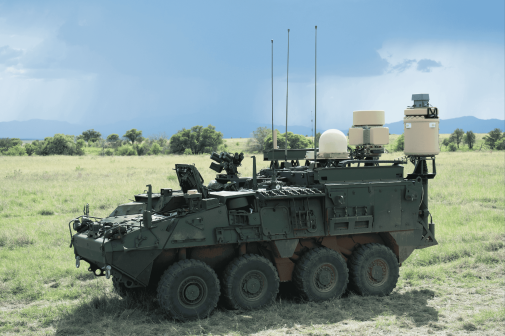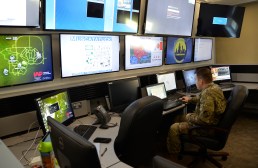Senate wants tighter cyber-electronic warfare integration, clarity on organizations for cyber ops

The Senate Armed Services Committee wants a strategy and more coherent integration of cyber and electronic warfare effects in military operations.
A provision in the committee’s version of the fiscal 2023 National Defense Authorization Act is requiring the Department of Defense to develop a strategy for “converged cyber and electronic warfare conducted by and through deployed military and intelligence assets operating in the radiofrequency domain to provide strategic, operational and tactical effects in support of combatant commanders.”
The committee passed its version of the bill June 16 but did not release the text until July 18.
There are significant similarities between cyberspace effects and electronic warfare, especially in the tactical sphere of battle. Some services, namely the Army, but the Marine Corps as well, have developed tactically focused forces to exploit these capabilities and similarities, primarily through what are known as radio-frequency effects.
This is essentially cyber effects that exploit Wi-Fi or other wireless electronic systems using proximal or close access forces. Contrast that with what U.S. Cyber Command does primarily, which is Internet-Protocol based cyber operations, conducted remotely.
While authorities to conduct cyber operations are notoriously onerous and held at the top levels of government, these more proximal effects conducted through radio-frequency require fewer levels of approval.
In fact, in a report accompanying the SASC’s bill language, the committee noted these “service retained” forces, a distinction from the cyber mission force, which each service presents to and is owned by Cyber Command.
“The committee believes it is essential for the Department to determine its requirements and roles for what are referred to as ‘service-retained’ cyber forces for both defensive and offensive support to combatant commands,” the report said. “The committee expects that these service-retained forces would become part of the personnel rotation through elements of the Cyberspace Operations Forces for career progression. These forces would also fulfill critical roles in protecting deployed and often disconnected weapons systems and platforms and supporting offensive cyber operations executed by military units and systems.”
The bill wants the DOD to develop recommendations regarding command and control, deconfliction and coordination relationships and processes between combatant commanders and the Cyber Command regarding tactical cyber operations and converged cyber and electronic warfare operations conducted prior to and during armed conflict.
Additionally, it charges DOD with developing requirements for service-retained tactical cyber forces for offensive and defensive missions.
As these capabilities and forces mature, it is expected that these proximal forces could actually gain accesses and pass that off to high end Cyber Command operators remotely to exploit. In fact, Cyber Command has budgeted for electronic warfare capabilities, requesting $16.7 million for tools to “adapt EW technology and cyber-peculiar capabilities to gain aces to targeted enemy forces,” according to budget documents.
The Army has created the 915th Cyber Warfare Battalion, which will ultimately encompass a total of 12 expeditionary cyber and electromagnetic activities teams, or ECT, by 2026 that will help plan tactical cyber operations for commanders and conduct missions in coordination with deployed forces.
The Marine Corps, for its part, has also developed tactical cyber forces within its Marine Expeditionary Force Information Groups (MIGs), which integrate electronic warfare with intelligence, communications, military information support operations, space, cyber and communication strategy to provide MEF commanders with an information advantage.
Optimizing Cyber Command
The bill also revisits questions from a previous NDAA regarding how elements under Cyber Command are organized, citing dissatisfaction that the DOD did not address several of the elements required.
Specifically, the committee wants a study to determine the optimal strategy for structuring and manning elements of the various Joint Force Headquarters-Cyber (JFHQ-C), Joint Mission Operations Centers, Cyber Operations-Integrated Planning Elements and Joint Cyber Centers.
The services do not own offensive teams. Instead, these teams work through several organizations, each formally known as Joint Force Headquarters-Cyber, which in turn provide planning, targeting, intelligence and cyber capabilities to the combatant commands to which they’re assigned. The heads of the four service cyber components also lead their respective JFHQ-C. These organizations oversee combat mission teams and combat support teams.
The Joint Mission Operations Centers are actually where the JFHQ-C commands and controls and executes cyber operations.
The Cyber Operations-Integrated Planning Element were created as a means of better integrating cyber operations into the overall planning process. Cyber planners, not actual operators, are physically embedded within various staff sections at the combatant commands to provide expertise on how cyber can be incorporated into their operations.
The Joint Cyber Centers are where combatant commands oversee all aspects of cyberspace operations.
The study must include:
- operational effects on the services if each of the entities listed above are restructured from organizations that are service component organizations to joint organizations;
- organizational effects on the services if the billets associated with the entities above are transferred to Cyber Command and designated as joint billets;
- operational and organizational effects on the services, Cyber Command, other combatant commands and the Joint Staff if the above entities are realigned, restructured, or consolidated, and;
- clarification of the relationship and differentiation between cyber operations–integrated planning elements and joint cyber centers of the combatant commands, among others.
The fiscal 2020 NDAA included a nearly identical provision.
However, Congress doesn’t appear satisfied with the information it was provided.
“The committee is frustrated that the previous report on this topic, as required by section 1656 of the National Defense Authorization Act for Fiscal Year 2020 (Public Law 116-92), did not address many of the required elements,” the committee notes in the report accompanying the bill. “The committee encourages the Department to fully address all of the elements required by this study and to provide robust recommendations on an optimal strategy for providing cyber support to the geographic combatant commands.”




